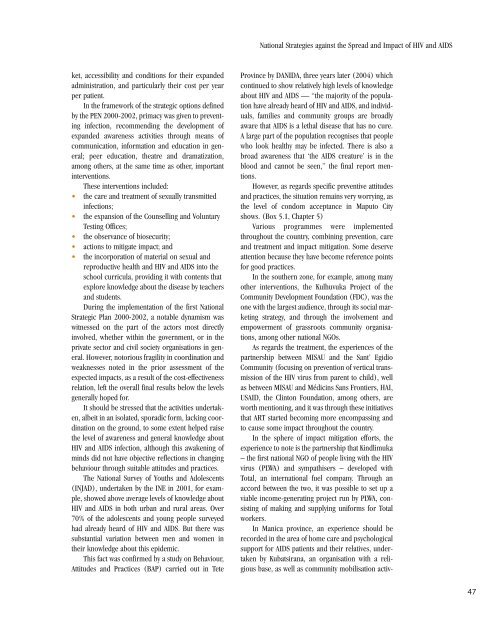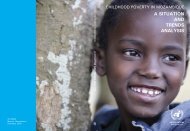English language version - Human Development Reports - United ...
English language version - Human Development Reports - United ...
English language version - Human Development Reports - United ...
- No tags were found...
Create successful ePaper yourself
Turn your PDF publications into a flip-book with our unique Google optimized e-Paper software.
National Strategies against the Spread and Impact of HIV and AIDSProvince by DANIDA, three years later (2004) whichcontinued to show relatively high levels of knowledgeabout HIV and AIDS — “the majority of the populationhave already heard of HIV and AIDS, and individuals,families and community groups are broadlyaware that AIDS is a lethal disease that has no cure.A large part of the population recognises that peoplewho look healthy may be infected. There is also abroad awareness that ‘the AIDS creature’ is in theblood and cannot be seen,” the final report mentions.However, as regards specific preventive attitudesand practices, the situation remains very worrying, asthe level of condom acceptance in Maputo Cityshows. (Box 5.1, Chapter 5)Various programmes were implementedthroughout the country, combining prevention, careand treatment and impact mitigation. Some deserveattention because they have become reference pointsfor good practices.In the southern zone, for example, among manyother interventions, the Kulhuvuka Project of theCommunity <strong>Development</strong> Foundation (FDC), was theone with the largest audience, through its social marketingstrategy, and through the involvement andempowerment of grassroots community organisations,among other national NGOs.As regards the treatment, the experiences of thepartnership between MISAU and the Sant’ EgidioCommunity (focusing on prevention of vertical transmissionof the HIV virus from parent to child), wellas between MISAU and Médicins Sans Frontiers, HAI,USAID, the Clinton Foundation, among others, areworth mentioning, and it was through these initiativesthat ART started becoming more encompassing andto cause some impact throughout the country.In the sphere of impact mitigation efforts, theexperience to note is the partnership that Kindlimuka– the first national NGO of people living with the HIVvirus (PLWA) and sympathisers – developed withTotal, an international fuel company. Through anaccord between the two, it was possible to set up aviable income-generating project run by PLWA, consistingof making and supplying uniforms for Totalworkers.In Manica province, an experience should berecorded in the area of home care and psychologicalsupport for AIDS patients and their relatives, undertakenby Kubatsirana, an organisation with a religiousbase, as well as community mobilisation activket,accessibility and conditions for their expandedadministration, and particularly their cost per yearper patient.In the framework of the strategic options definedby the PEN 2000-2002, primacy was given to preventinginfection, recommending the development ofexpanded awareness activities through means ofcommunication, information and education in general;peer education, theatre and dramatization,among others, at the same time as other, importantinterventions.These interventions included:• the care and treatment of sexually transmittedinfections;• the expansion of the Counselling and VoluntaryTesting Offices;• the observance of biosecurity;• actions to mitigate impact; and• the incorporation of material on sexual andreproductive health and HIV and AIDS into theschool curricula, providing it with contents thatexplore knowledge about the disease by teachersand students.During the implementation of the first NationalStrategic Plan 2000-2002, a notable dynamism waswitnessed on the part of the actors most directlyinvolved, whether within the government, or in theprivate sector and civil society organisations in general.However, notorious fragility in coordination andweaknesses noted in the prior assessment of theexpected impacts, as a result of the cost-effectivenessrelation, left the overall final results below the levelsgenerally hoped for.It should be stressed that the activities undertaken,albeit in an isolated, sporadic form, lacking coordinationon the ground, to some extent helped raisethe level of awareness and general knowledge aboutHIV and AIDS infection, although this awakening ofminds did not have objective reflections in changingbehaviour through suitable attitudes and practices.The National Survey of Youths and Adolescents(INJAD), undertaken by the INE in 2001, for example,showed above average levels of knowledge aboutHIV and AIDS in both urban and rural areas. Over70% of the adolescents and young people surveyedhad already heard of HIV and AIDS. But there wassubstantial variation between men and women intheir knowledge about this epidemic.This fact was confirmed by a study on Behaviour,Attitudes and Practices (BAP) carried out in Tete47
















